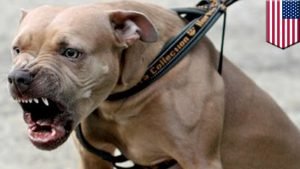Key Points:
- Pitbulls bites are more likely to cause significant injuries than many other dog breeds.
- Pitbulls are statistically more likely to bite when compared to all the other dog breeds. They even outperform the Rottweiler in reported dog bites.
- Appropriate and immediate medical care for any dog bite can help the victim avoid infection and other complications.
- Proper socialization and training of Pitbulls can result in a welcome companion and family dog, but it requires consistency from owners.
- An attack by a pitbull may result in a legal claim/lawsuit against the dogs owner. Fortunately, a dog owner’s home or renter’s insurance policy may cover the attack.
When the American Pitbull Terrier came to this country, it became an all-around working dog, cattle herder, hunting partner, and family protector. In the early 1900s, Pitbulls were even called “nanny dogs” because of their loyal and gentle nature toward humans, and especially children.
But sadly, as time passed, bad owners began to exploit these strong dogs by training them to be aggressive, fight, and attack. Pitbulls are also known to be used in illegal dog fighting rings and bred to be even bigger and stronger than usual.
Although dog attacks happen among all breeds, several highly publicized and gruesome Pitbull maulings ultimately led to all-out bans on these and similar dogs in some areas.
Still, despite their reputation, Pitbull dogs are very popular in the United States. In fact, about 20% of the dogs are classified as Pitbulls.
Different Types of Pitbulls

While dogs identified by their “weight-lifter” musculature, broad heads, and stocky stature often get identified as Pitbulls, there is actually not an official “Pitbull” breed.
Instead, there are four breeds — most are members of the terrier group — that are commonly classified within the “Pitbull-type” breeds by American Kennel Club and United Kennel Club standards.
- American Pitbull Terrier (APBT) – Stands taller and is the most athletic of the four Pitbull-type breeds.
- American Staffordshire Terrier – Slightly shorter and stockier than the APBT.
- The Staffordshire Bull Terrier – The smallest of the four.
- The American Bully – The Bully is stouter than the other three and has an appearance similar to the classic American Bulldog breed.
Pitbull dogs have a reputation for biting because they are larger dogs that can do significant damage or cause fatalities if and when they do bite. Therefore, the victims are more likely to need medical attention and report the attack.
Pitbull attacks can happen for a number of reasons, but most often, it’s due to poor or improper training by the dog’s owner. Some owners may even train their animals to be aggressive, which can be a recipe for disaster.
When a dog owner fails to train or socialize any dog properly, that animal may bite without provocation. In these cases, some say that the owners may be criminally negligent of setting up a tragedy.
Pitbull Attack Statistics
During the 15-year period from 2005 to 2020, dogs killed 568 Americans. Of these fatalities, Pitbulls contributed to 67% or 380 of them.
From 2011 to 2021, Level I trauma centers across several regions of the country completed 15 peer-reviewed retrospective medical studies. These studies reported similar findings regardless of geographical area.
The results showed that Pitbulls inflicted more injuries than other dog breeds – including the Rottweiler. The majority of these studies (12 of the 15) also demonstrated that injuries inflicted by Pitbulls are the most severe and require a higher number of surgical interventions – which can be up to five times higher than injuries by other dog breeds.
Pitbulls Rank Among the Most Dangerous Dogs to Children
Unfortunately, children are very often the victims of canine attacks. Because of a child’s small size in relation to the attacking dog, facial, neck, and head wounds are most prevalent. These injuries can cause serious scarring and be responsible for multiple reconstructive surgeries and, yes, even fatalities.
According to a study cited by DogsBite.org, of 356 patients in the Richmond, Virginia area, children ages 6 to 12 suffered the most injuries (45%). Pitbulls inflicted the highest prevalence of injuries (53%) when the attacking breed was known. In addition, Pitbulls were more likely to bite children ages 6 to 12 (36.2%).
According to DogsBite.org, data from Level 1 Trauma Centers demonstrate that when measured against other dog breeds, Pitbull terriers inflicted more complex wounds, attacked more often when unprovoked, and left their properties more frequently to attack. Among these attacks, the probability of a bite resulting in a complex wound was 4.4 times higher with Pitbulls than different breeds. The odds of an off-property attack by a Pitbull were 2.7 times greater than that for other breeds.
Treating a Dog Bite Wound
According to The Cleveland Clinic, below are the seven steps you should immediately take if you are bitten by any dog. It is also recommended that you seek professional medical care within eight hours of a bite, even if the wound doesn’t seem serious.
- Wash the wound using mild soap and warm tap water. Run the water over the injury for a full five to 10 minutes.
- Slow the bleeding with a clean cloth by applying pressure.
- Apply over-the-counter antibiotic cream if it is available.
- Wrap the wound in a sterile bandage.
- Keep the wound covered and see your doctor as soon as possible.
- Change the bandage several times each day, or according to your doctor’s recommendations.
- Watch for signs of infection, such as redness, swelling, increased pain, or fever. Call your doctor if any of these symptoms develop.
Apart from complications involving infections, which can lead to sepsis and death, other possibly fatal issues can be associated with dog bites. Medical News Today lists several additional dog-bite complications, including Tetanus or lockjaw, which are possible with any puncture wounds.
In addition, rabies can be a significant concern, especially if the attack was from a stray dog or one who is not cared for properly. Though the disease has diminished in many areas of the world where there are more domestic animal populations, it is by no means eradicated. Rabies should always be a concern when any animal bite occurs, including from squirrels or raccoons. A course of immunizations may be necessary, as the disease can be fatal if not treated early enough.
Each of these complications can be mitigated by seeing a doctor immediately following a biting incident.
Infections – A Serious Complication of Dog Bites
Infections, including Capnocytophaga, from dog bite wounds are the most common reason people visit the hospital for medical emergencies.
According to the website Dogsbite.org, about 42% of people who go to the emergency room for dog-bite-related care wait until infection sets in, a common but potentially deadly mistake. Again, dog bite victims should seek medical care within eight hours of the incident to prevent infection from occurring.

 1201 West Peachtree Street #2339 Atlanta, GA 30309+1-770-212-3795$0-$100000
1201 West Peachtree Street #2339 Atlanta, GA 30309+1-770-212-3795$0-$100000Amanda has always been courteous and quite responsive with problem solving.

What Can Pitbull Owners Do to Help Prevent Their Dogs from Biting
Ethical owners of bullies are almost always champions for the breed and tout them as loving family pets that are gentle and friendly with children, the elderly, and anyone else. Even dog training experts and scientists agree that aggressive behavior is generally learned by the dog as a result of abusive treatment or training, and not due to a specific breed.
Still, dogs are animals. Therefore, it’s virtually impossible to promise a dog won’t ever bite. However, dog owners must take the responsibility to train their dogs to behave and be good canine citizens – to do less is reckless and may constitute negligence.
The key to curbing aggression in Pitbulls is to start training early. Like any other puppies, pit puppies might bite out of excitement or in play. It’s crucial to take immediate steps to teach them there are consequences for this action.
If your dog is an adult, these lessons may take more time. But don’t be discouraged, an old dog can still learn new tricks.
Our research has found some tips and techniques to train dogs properly and discourage aggressive behavior.
- Make a big fuss over biting. Say “OUCH” loudly and act as if you are hurt. You might not be, but the dog will respond properly as he wants your attention and love.
- Use the command “NO” in a stern voice.
- Immediately stop paying attention or playing with the dog for a few minutes (give him a time-out).
- Understand that a dog’s “fear” is most often the trigger for aggressive behavior. If you fail to socialize these (or any other) dogs, and later expose them to other people, they may become fearful of strangers and behave aggressively.
- Adequate exercise for these athletic dogs is pivotal; without it, they may grow agitated, which can lead to aggression.
- Food aggression must also be curbed early, or it could become a life-long habit. If your puppy is territorial over his food, pick the food up and take it away from him for a few minutes. You should repeat this lesson until he is no longer aggressive at mealtime.
- Teach your dog a “drop it” command, so that if he does bite, he will stop.
- If the dog bites for your attention, walk away and ignore it. Don’t reward him with attention for bad behavior.
- Enroll your dog in obedience class.
- Be certain your dog is spayed or neutered.
- Reward good behavior with plenty of affection and treats.
Introducing deterrence measures to remove the temptation to bite is a good first step. The second step is to start channeling the dog’s energy into something safe and more productive, like exercise and activities.
Striking a dog will never work well – it may trigger fear that compounds the problem. Instead, introduce positive reinforcements to teach them that not biting results in a reward. This will ultimately bring their biting under control and keep you from legal action later.










